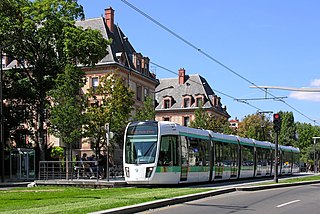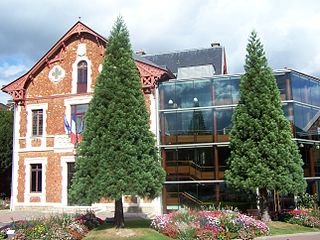
Meudon is a municipality in the southwestern suburbs of Paris, France. It is in the département of Hauts-de-Seine. It is located 9.1 km (5.7 mi) from the center of Paris. The city is known for many historic monuments and some extraordinary trees. One of them, the Imperial Cedar, attracted the attention of Empress Eugénie and Queen Victoria. As of March 2021, the tree is in good condition, but it is threatened by real estate speculation. Another real estate project is planned for the historic park of the Napoleon III villa built by Charles Schacher. Both projects are controversial and have aroused local opposition.

Châtillon is a commune in the southwestern suburbs of Paris, France. It is located 7 km (4.3 mi) from the center of Paris.

Chaville is a commune in the Hauts-de-Seine department and Île-de-France region of north-central France. It lies some 12 km from the centre of Paris in the south-western suburbs of the French capital.

Issy-les-Moulineaux is a commune in the southwestern suburban area of Paris, France, lying on the left bank of the river Seine. Its citizens are called Isséens in French. It is one of Paris' entrances and is located 6.6 km (4.1 mi) from Notre-Dame Cathedral, which is considered Kilometre zero of France. On 1 January 2010, Issy-les-Moulineaux became part of the Grand Paris Seine Ouest agglomeration community, which merged into the Métropole du Grand Paris in January 2016.

Champ de Mars–Tour Eiffel is a station on RER C in Paris. The site has accommodated a total of five stations, the last of which remains in service for the Paris RER.

The arrondissement of Boulogne-Billancourt is an arrondissement of France in the Hauts-de-Seine department in the Île-de-France region. It has 8 communes. Its population is 318,535 (2016), and its area is 36.5 km2 (14.1 sq mi).

The arrondissement of Versailles is an arrondissement of France in the Yvelines department in the Île-de-France region. It has 23 communes. Its population is 413,956 (2016), and its area is 187.2 km2 (72.3 sq mi).
The Compagnie des chemins de fer de l'Ouest, often referred to simply as L'Ouest or Ouest, was an early French railway company which operated from the years 1855 through 1909.

Vélizy-Villacoublay is a commune in the Yvelines department in the Île-de-France in north-central France. It is located in the south-western suburbs of Paris 13.9 km (8.6 mi) from the center and 3.2 km (2.0 mi) east of Versailles. Its inhabitants are called Véliziens.

The Île-de-France tramways consists of a network of modern tram lines in the Île-de-France region of France. Eleven lines are currently operational, with extensions and additional lines in the planning and construction stage. Although the system mainly runs in the suburban regions of Paris, lines T3a and T3b run entirely within Paris city limits, and line T2 also does so for part of its route. While the lines operate independently of each other and are generally unconnected, some connections do exist: between lines T2 and T3a, T3a and T3b, T1 and T5, T1 and T8 and T8 and T11 Express. However, the final design of the entire planned tram network is fairly integrated.

Viroflay is a commune in the Yvelines department in the Île-de-France in north-central France. It is located in the south-western suburbs of Paris 14.1 km (8.8 mi) from the center and 3 km (1.9 mi) from the Palace of Versailles.

Transilien Line U, also known as "La Défense - La Verrière" or more often simply "ligne U", is a tangential commuter train link, which serves the western Paris region from La Défense. It links the Paris's business district of La Défense to La Verrière station, in the south-west of Ile-de-France. It is the only commuter train line in the Transilien network that does not originate from a large Parisian station. The line has 55,000 passengers per weekday in 2014.

Route nationale 10, or RN 10, is a trunk in France between Paris and the border with Spain via Bordeaux.

Île-de-France tramway Line 2 is part of the modern tram network of the Île-de-France region of France. It connects the commune of Bezons in the north to the Porte de Versailles Métro station in Paris in the south, serving Hauts-de-Seine and its La Défense business district.
The Battle of Issy was fought on the 2 and 3 July 1815 in and around the village of Issy, a short distance south west of Paris. The result was a victory for Prussian General von Zieten over a French army commanded by General Dominique Vandamme.
The Château d'Issy, at Issy-les-Moulineaux, in the Hauts-de-Seine department of France, was a small French Baroque château on the outskirts of Paris. It was destroyed during the Paris Commune of 1871.

Ernest Archdeacon was a French lawyer and aviation pioneer before the First World War. He made his first balloon flight at the age of 20. He commissioned a copy of the 1902 Wright No. 3 glider but had only limited success. He was regarded as France's foremost promoter and sponsor of aviation, offering prizes, commissioning designs, and organising tests and events.

After their defeat at the Battle of Waterloo on 18 June 1815, the French Army of the North, under the command of Napoleon Bonaparte retreated in disarray back towards France. As agreed by the two Seventh Coalition commanders in chief, the Duke of Wellington, commander of the Anglo-allied army, and Prince Blücher, commander of the Prussian army, the French were to be closely pursued by units of the Prussian army.















